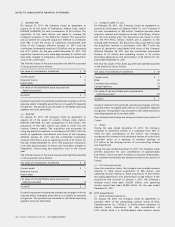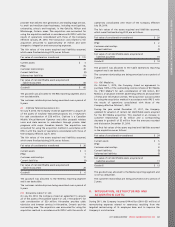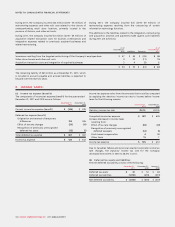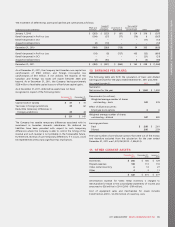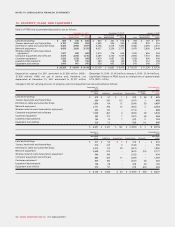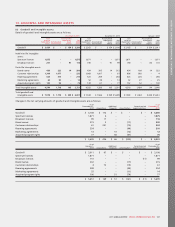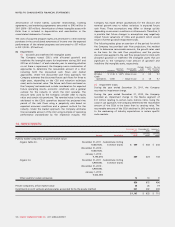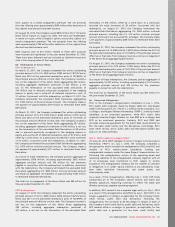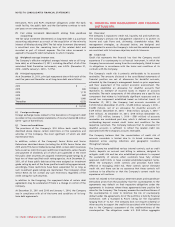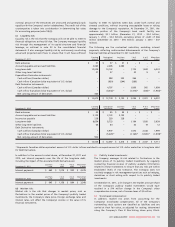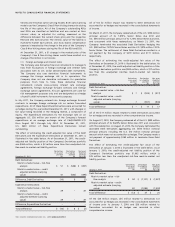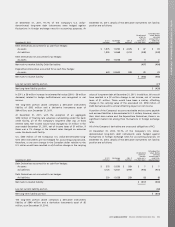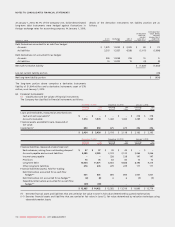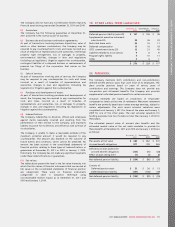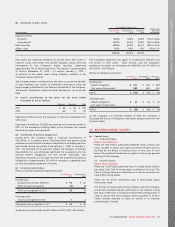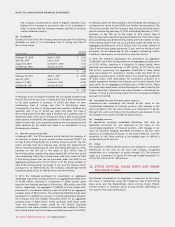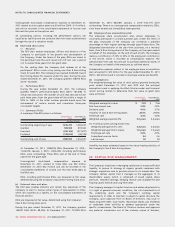Rogers 2011 Annual Report Download - page 116
Download and view the complete annual report
Please find page 116 of the 2011 Rogers annual report below. You can navigate through the pages in the report by either clicking on the pages listed below, or by using the keyword search tool below to find specific information within the annual report.
NOTES TO CONSOLIDATED FINANCIAL STATEMENTS
Derivatives. RCl’s and RCP’s respective obligations under the bank
credit facility, the public debt and the Derivatives continue to rank
pari passu on an unsecured basis.
(f) Fair value increment (decrement) arising from purchase
accounting:
The fair value increment (decrement) on long-term debt is a purchase
accounting adjustment as a result of the acquisition of the minority
interest of Wireless during 2004. The fair value increment (decrement)
is amortized over the remaining term of the related debt and
recorded as part of interest expense. The fair value increment is
applied to the specific debt instruments to which it relates.
(g) Weighted average interest rate:
The Company’s effective weighted average interest rate on all long-
term debt, as at December 31, 2011, including the effect of all of the
associated Debt Derivative instruments, was 6.22% (December 31,
2010 – 6.68%; January 1, 2010 – 7.27%).
(h) Principal repayments:
As at December 31, 2011, principal repayments due within each of the
next five years and thereafter on all long-term debt are as follows:
2012 $ –
2013 606
2014 1,119
2015 844
2016 1,000
Thereafter 6,533
$ 10,102
(i) Foreign exchange:
Foreign exchange losses related to the translation of long-term debt
recorded in the consolidated statements of income totalled $8 million
(2010 – gain of $20 million).
(j) Terms and conditions:
The provisions of the Company’s $2.4 billion bank credit facility
described above impose certain restrictions on the operations and
activities of the Company, the most significant of which are debt
maintenance tests.
In addition, certain of the Company’s Senior Notes and Senior
Debentures described above (including the 6.25% Senior Notes due
2013 and 8.75% Senior Debentures due 2032) contain debt incurrence
tests as well as restrictions upon additional investments, sales of assets
and payment of dividends, all of which are suspended in the event
the public debt securities are assigned investment grade ratings by at
least two of three specified credit rating agencies. As at December 31,
2011, all of these public debt securities were assigned an investment
grade rating by each of the three specified credit rating agencies and,
accordingly, these restrictions have been suspended for so long as
such investment grade ratings are maintained. The Company’s other
Senior Notes do not contain any such restrictions, regardless of the
credit ratings for such securities.
In addition to the foregoing, the repayment dates of certain debt
agreements may be accelerated if there is a change in control of the
Company.
At December 31, 2011 and 2010 and January 1, 2010, the Company
was in compliance with all of the terms and conditions of its long-
term debt agreements.
18. FINANCIAL RISK MANAGEMENT AND FINANCIAL
INSTRUMENTS:
(a) Overview:
The Company is exposed to credit risk, liquidity risk and market risk.
The Company’s primary risk management objective is to protect its
income and cash flows and, ultimately, shareholder value. Risk
management strategies, as discussed below, are designed and
implemented to ensure the Company’s risks and the related exposures
are consistent with its business objectives and risk tolerance.
(b) Credit risk:
Credit risk represents the financial loss that the Company would
experience if a counterparty to a financial instrument, in which the
Company has an amount owing from the counterparty, failed to meet
its obligations in accordance with the terms and conditions of its
contracts with the Company.
The Company’s credit risk is primarily attributable to its accounts
receivable. The amounts disclosed in the consolidated statements of
financial position are net of allowances for doubtful accounts,
estimated by the Company’s management based on prior experience
and their assessment of the current economic environment. The
Company establishes an allowance for doubtful accounts that
represents its estimate of incurred losses in respect of accounts
receivable. The main components of this allowance are a specific loss
component that relates to individually significant exposures and an
overall loss component established based on historical trends. At
December 31, 2011, the Company had accounts receivable of
$1,574 million (December 31, 2010 – $1,443 million; January 1, 2010 –
$1,289 million), net of an allowance for doubtful accounts of
$129 million (December 31, 2010 – $138 million; January 1, 2010 –
$157 million). At December 31, 2011, $719 million (December 31,
2010 – $712 million; January 1, 2010 – $561 million) of accounts
receivable are considered past due, which is defined as amounts
outstanding beyond normal credit terms and conditions for the
respective customers. The Company believes that its allowance for
doubtful accounts is sufficient to reflect the related credit risk
associated with the Company’s accounts receivable.
The Company believes that the concentration of credit risk of
accounts receivable is limited due to its broad customer base,
dispersed across varying industries and geographic locations
throughout Canada.
The Company has established various internal controls, such as credit
checks, deposits on account and billing in advance, designed to
mitigate credit risk and has also established procedures to suspend
the availability of services when customers have fully utilized
approved credit limits or have violated established payment terms.
While the Company’s credit controls and processes have been
effective in managing credit risk, these controls cannot eliminate
credit risk and there can be no assurance that these controls will
continue to be effective or that the Company’s current credit loss
experience will continue.
Credit risk related to the Company’s Debt Derivatives and Expenditure
Derivatives arises from the possibility that the counterparties to the
agreements may default on their respective obligations under the
agreements in instances where these agreements have positive fair
value for the Company. The Company assesses the creditworthiness of
the counterparties in order to minimize the risk of counterparty
default under the agreements. All of the portfolio is held by financial
institutions with a Standard & Poor’s rating (or the equivalent)
ranging from A– to AA–. The Company does not require collateral or
other security to support the credit risk associated with its Derivatives
due to the Company’s assessment of the creditworthiness of the
counterparties. The obligations under U.S. $4.9 billion aggregate
112 ROGERS COMMUNICATIONS INC. 2011 ANNUAL REPORT


